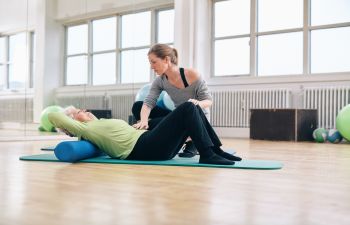
There are many conditions that cause pain and discomfort in the back. Spinal stenosis is among the most common, as it is a condition that tends to develop as a response to the natural aging process. Spinal stenosis is the narrowing of the vertebrae along the spinal column, which can put pressure on the nerves that travel along this space. While this condition can occur in the upper back and neck (cervical stenosis), it is most often found in the lumbar spine (lower back).
If you suffer from spinal stenosis, you may experience a wide range of disruptive symptoms. The pain can make physical activity (and especially exercising) seem unbearable. However, if you have spinal stenosis, there is a tricky line when it comes to exercise and rest. While resting a flare-up in your back is important and beneficial, a lack of physical activity can also make things worse in the long run. Of course, doing the wrong exercises can also exacerbate the painful symptoms of spinal stenosis. Therefore, it is important for spinal stenosis patients to understand the difference between good and bad movement when it comes to their condition.
Activities to Avoid
Knowing what is helpful and what is harmful is important when exercising with spinal stenosis. However, the cause of your spinal narrowing can also help determine which movements are best. In general, the following are accurate guidelines when exercising with spinal stenosis:
Excessive Back Extension: In most cases, leaning or bending backwards increases the compression of your spine and can make your inflammatory symptoms worse.
Long Walks or Running: The repetitive impact of running or a long walk is not ideal for a narrowed spine that lacks cushioning and flexibility. Consider shorter, more tolerable distances instead.
Certain Stretches and Yoga Poses: Many patients falsely assume that yoga is a safe, low-impact exercise for their spine. The truth is, there are certain positions that involve back extensions and can make spinal stenosis worse, including cobra, the bridge, “Superman” and others.
Loading a Rounded Back: Strengthening the muscles that support the spine can greatly improve your comfort with spinal stenosis. However, there are certain free weight exercises that can be detrimental to your condition, especially if they are performed incorrectly. These often include standing weighted exercises in which your hips are hinged, such as dead lifts, flies and bent-over rows.
Movements to Consider
While you may be intimidated by all of the exercises you shouldn’t do with spinal stenosis, don’t make the mistake of not moving at all. Too much bed rest will cause the muscles around the spine to atrophy, which can worsen your range of motion and pain. Instead, consult with a physical therapist about the best type and duration of physical activity for you. At Manhattan Sports Therapy, we help patients manage spinal stenosis and achieve the most active and comfortable lifestyle possible. Our clinic offers a range of therapies to address spinal stenosis, including physical therapy, chiropractic, massage and other non-invasive services.
Posted on behalf of
515 Madison Avenue FL 22A
New York, NY 10022
Phone: (212) 310-0100
Email: sportstherapy150@icloud.com


